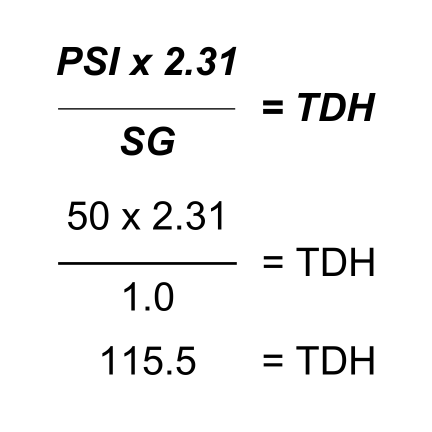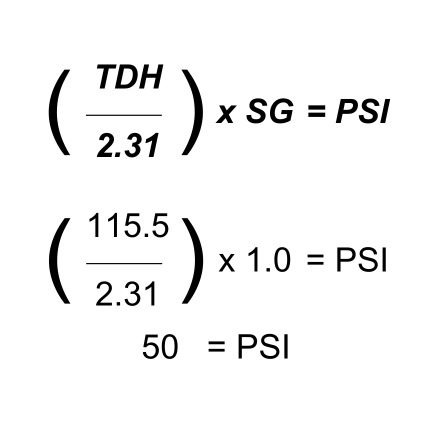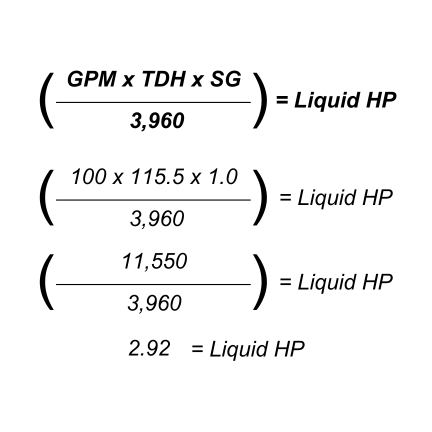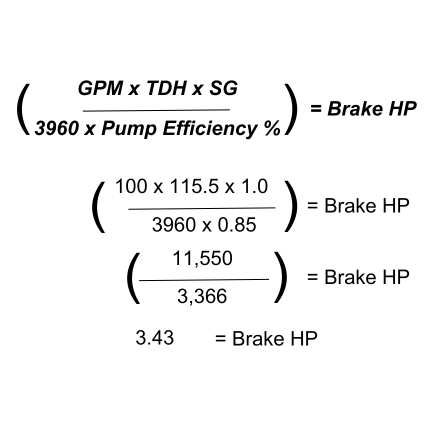When it comes to pump maintenance, sometimes you need to use conversions to get the right answers for a proper pump assessment. Have you ever found yourself searching online for formulas to fill in the gaps? That's where our engineers' "pump conversion toolbox" comes in handy. This collection of essential calculations covers everything from specific gravity to pressure and power. We've worked through some of the most common conversions so you can understand the process and apply it yourself. With a bit of calculation, you'll be ordering parts and solving pump issues faster than ever before. [insert table image] Let’s say you need a pump that can add 50 PSI to your system, but your pump curve only shows pressure in Total Dynamic Head (TDH). How do you convert PSI to TDH? We’ve used the standard pressure formula and applied it using water as the fluid, which has a specific gravity (SG) of 1.0. Start by multiplying your PSI value (50) by the constant 2.31. Then divide that result by the fluid's SG (1.0). The answer is 115.5 TDH, which means you should look for a pump that can deliver this head at your required flow rate. Converting TDH back to PSI is just as straightforward. If you have a pump curve that shows TDH, you can easily find out what pressure it will produce. For example, if your TDH is 115.5, divide that by 2.31 and then multiply by the fluid's SG (1.0). This gives you 50 PSI, confirming the pressure your pump will deliver. If you want to know how much horsepower your fluid is generating at a given flow and pressure, you need to calculate Hydraulic Horsepower (LHP). To do this, you’ll need the gallons per minute (GPM), total dynamic head (TDH), and the specific gravity (SG) of your fluid. For example, if your GPM is 100, TDH is 115.5, and SG is 1.0 (water), multiply these three values together. Then divide by the constant 3,960. This gives you a Hydraulic Horsepower of 2.92 HP. If you're looking to determine the input power delivered by the motor to the pump, you need to calculate Brake Horsepower (BHP). To do this, you’ll need GPM, TDH, SG, and the pump’s efficiency percentage (usually found on the pump curve). In this example, GPM is 100, TDH is 115.5, SG is 1.0, and the pump efficiency is 85%. Multiply GPM, TDH, and SG, then divide by the product of 3,960 and 0.85 (the efficiency). This gives a Brake Horsepower of 3.43 BHP. (Tip: The difference between BHP and LHP is the pump’s efficiency. You can also take LHP and divide it by the efficiency to get BHP.) If you'd like us to help with more examples or different scenarios, feel free to reach out. Our team is always ready to assist with your pump needs. Our engineers are dedicated to helping customers find the right pump solutions every day. Whether it's solving complex problems or ensuring your new pumps integrate smoothly into your system, we’re here to support you. Get your calculations checked by one of our experts today. Contact Us Electric Vehicle Die Casting Mold Electric Control Box Die Casting Mold, New Energy Die Casting Mold, High Pressure Casting Molds, Controller Die Casting Mould Ningbo Xuao Machinery Co.,Ltd , https://www.xuao-machinery.comSection 1: How to Calculate Pressure Conversions
How to Convert PSI to TDH

How to Convert TDH to PSI

Section 2: How to Calculate Horsepower Conversion
How to Calculate Hydraulic (Liquid) Horsepower

How to Calculate Brake Horsepower

TALK WITH AN EXPERT